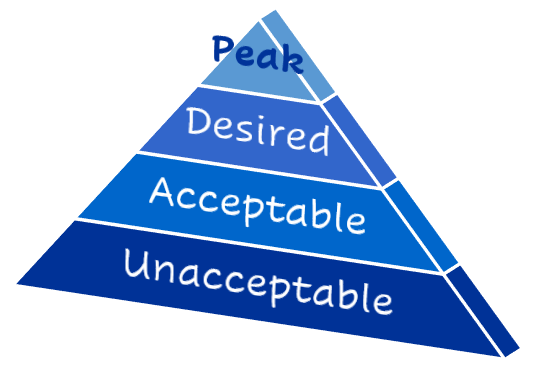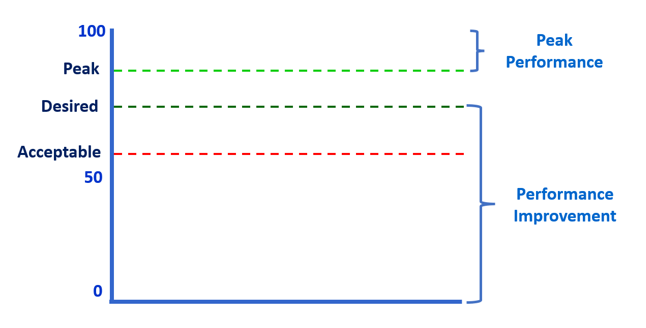Four Levels of Performance
Many people and organizations categorize performance at different levels. Some organizations just have two levels; meets or does not meet. Those organizations are mostly concerned about either meeting or not meeting the required performance levels.
However, most organizations will have at least three classifications, while some may even have five levels. The straightforward three level grouping may include meets, exceeds, and needs improvement. The five level may include wording such as outstanding, exceeds expectations, meets expectations, need improvement, and unacceptable.
There is not one performance classification format that will work best for all organizations. Each organization needs to determine which is most effective for them. Some may be content with just meets or does not meet. However, if an organization is looking to focus on improving individual performance and having their employees achieve their optimal performance level, they need at least four basic levels. Without the peak, outstanding or exceptional rating level, employees tend not to excel at their work. They need incentive, feedback and recognition to perform at their best.
Four Levels of Performance
There are four basic levels of individual performance:
- Peak
- Desired
- Acceptable
- Unacceptable
Peak – The individual is exceeding the desired level of performance and is achieving the optimum level of performance
Desired – The individual is exceeding acceptable level and is meeting the set desired level
Acceptable – The individual is meeting the set minimum level of performance, but not the desired level
Unacceptable – The individual is not meeting the set minimum level of performance
Four Levels of Performance Explained
Assessing the level of performance from the lowest to the highest level.
Unacceptable Level of Performance
The lowest performance level on most classification charts is “unacceptable” or “does not meet.” This means the individual is not meeting the set minimum level of performance. If this is the case for an employee, they may be let go from the organization or placed on a Performance Improvement Plan (PIP).
Acceptable Level of Performance
The level above unacceptable may be called “acceptable” or “meets.” This means the individual is meeting the set minimum level of performance but is not at the level the organization truly desires. Often organizations have a level, above where a person simply meets the minimum performance levels, where they want their employee’s performance to be.
For example, a company may require their employees to make at least 10 widgets a day, however, the company desires each employee make 12 widgets per day. Those employees who make only 10 widgets a day may be placed on an action plan to improve their performance even though they are hitting the minimum levels. However, many times this group gets forgotten in the performance improvement cycle because they are reaching the minimum level. It is important to distinguish acceptable from desired.
Lastly, organizations often look at employees who are performing only at the acceptable level as expendable. If that employee is replaced by another person, there is a good chance the new person will meet the desired level and not just the minimum level.
Desired Level of Performance
The level above “acceptable” is the desired level. This means the individual is exceeding the basic acceptable level and is meeting the set desired level.
This is the most overlooked level when it comes to performance improvement. At this level, individuals are often told “keep doing what you are doing.” There often is minimal feedback or assistance to help that person perform better. Without that feedback and direction, that person is unlikely to achieve a higher level of performance.
Peak Level of Performance
The highest level of performance is “peak” or “exceptional.” This means the individual is achieving the optimum level of performance. Obviously, this is the most desired level for performance.
At this level, there is not a substantial need for performance improvement. However, there is an immense need for rewards and recognition. Without the rewards and recognition, the person can feel unappreciated, and their performance may slide. Since these are the employees that organizations covet, it is imperative to ensure there is an incentive program so they continue to reach the peak level.


